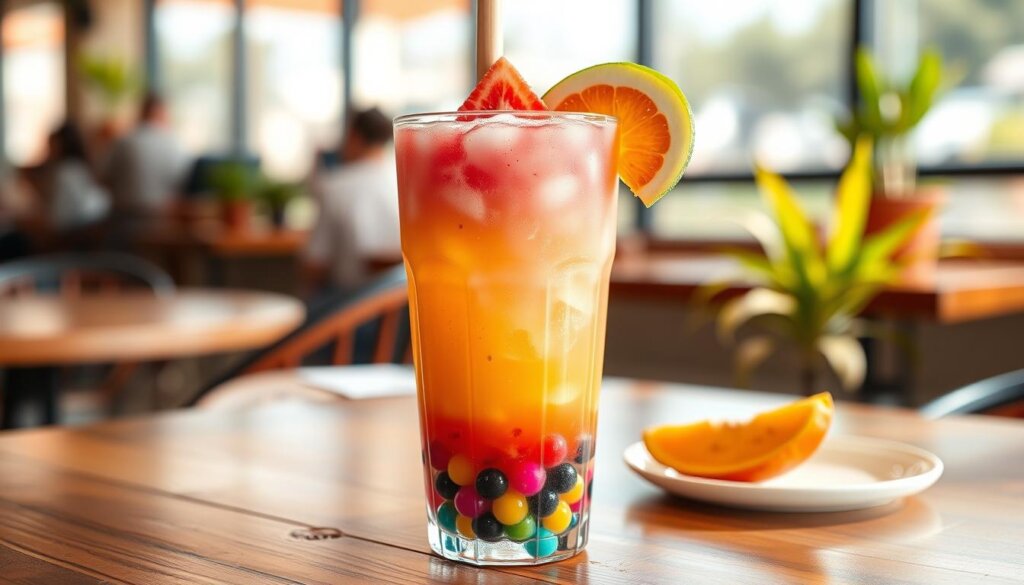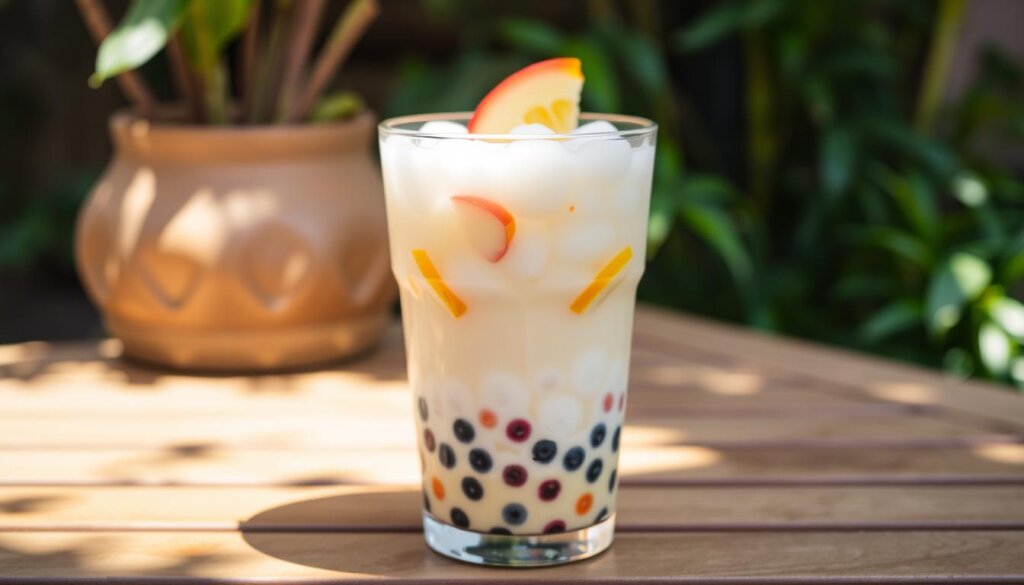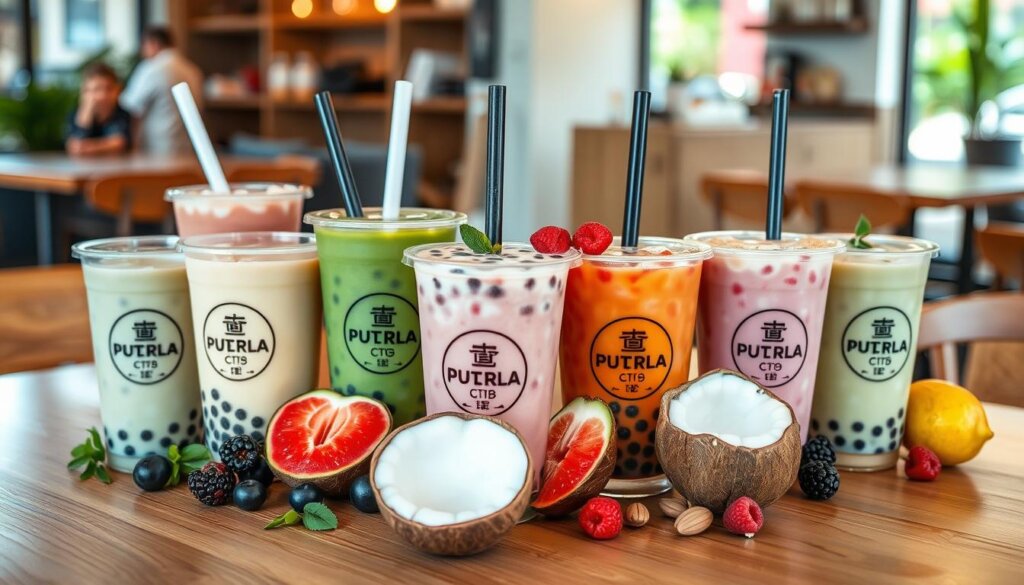Have you ever wondered if your favorite bubble tea is truly safe for a gluten-free diet? This popular drink has taken the world by storm with its sweet flavors and chewy tapioca pearls. For those with gluten sensitivities or celiac disease, it’s essential to know exactly what’s in your cup.
While bubble tea is often considered gluten-free, the risk lies in some of its ingredients, like flavored powders or additives, which may contain gluten. Each cup of bubble tea, costing an average of $1.50, reflects just how much people love this drink. But is your bubble tea as gluten-free as you think?
To explore more about gluten-free drink options, check out our guide to Twisted Tea’s Gluten-Free Status or learn about gluten safety in hard ciders with our Gluten-Free Hard Cider guide. In this article, we’ll dive into the ingredients of bubble tea and uncover safe choices for those on a gluten-free diet.
Table of contents
- What Exactly Is Bubble Tea?
- Is Bubble Tea Gluten Free? The Truth About Boba Safety
- Understanding Bubble Tea Base Ingredients
- Potential Sources of Gluten in Bubble Tea
- Cross-Contamination Risks at Bubble Tea Shops
- Safe Bubble Tea Options for Gluten-Sensitive Individuals
- Making Gluten-Free Bubble Tea at Home
- Conclusion: Enjoying Bubble Tea on a Gluten-Free Diet
- FAQ
What Exactly Is Bubble Tea?
Bubble tea, also known as boba tea, is a refreshing drink from Taiwan. It’s made with tea, milk, and chewy tapioca pearls, or “boba”. You can have it hot or cold, with many flavors and styles. The bubble tea ingredients include tea, milk, and tapioca pearls.
The main parts of bubble tea are tea, milk, and boba tea components like tapioca pearls. Some bubble teas have gluten, so people with celiac disease or gluten sensitivity should check the ingredients. You can find different teas like green, black, and herbal tea as the base for bubble tea.
Modern bubble tea offers a wide range of flavors and styles. You can find fruit-flavored tea, milk tea, and yogurt-based drinks. The boba tea components, such as tapioca pearls, popping boba, and jelly, make the drink fun and unique. With so many choices, you can pick the perfect bubble tea for your taste.
Brands like JOYBA offer gluten-free bubble tea options. Their products use high-quality ingredients and are free from artificial sweeteners and preservatives. Enjoying their bubble tea drinks is safe for those with gluten sensitivity.
Is Bubble Tea Gluten Free? The Truth About Boba Safety
When it comes to gluten-free boba, the main parts of bubble tea like tapioca pearls, tea, milk, and ice are naturally gluten-free. But, there are things that might add gluten to your tea. Flavored syrups or oat milk are examples.
To make sure your bubble tea is gluten-free, pay attention to what’s in it and how it’s made. You can pick gluten-free options and ask about the shop’s methods. For instance, choose fruit-based ingredients or gluten-free verified options.

- Here are some tips for gluten-free bubble tea:
- Always check labels and ask about allergens.
- Stay away from gluten in add-ons or syrups.
- Don’t use oat milk or choose gluten-free alternatives.
- Make your own bubble tea with gluten-free tapioca pearls and milk.
Being aware of gluten risks and taking steps to avoid them lets you enjoy gluten-free boba safely. Always check labels, ask about ingredients, and pick gluten-free options for a worry-free experience.
Understanding Bubble Tea Base Ingredients
Bubble tea’s base ingredients are key to its taste and safety, important for those with dietary needs. You can pick from black tea, green tea, and more, all gluten-free. This is good news for those avoiding gluten.
The main parts of bubble tea, like tea and milk, don’t have gluten. But, some ingredients might, so people with gluten issues should check. For dairy-free options, many places offer non-dairy milks, perfect for those avoiding dairy.
Bubble tea’s sweeteners and flavorings also matter for taste and safety. Common sweeteners like cane sugar add calories. To make it healthier, choose lower-calorie options or ask for less sugar.
Tea Types and Their Gluten Status
Most teas, like green and black, are gluten-free, which is good for those with gluten issues. But, flavored teas might have gluten, so always check the ingredients.
Milk and Non-Dairy Alternatives
For dairy-free bubble tea, there are many non-dairy milks like almond and soy milk. These are great for those avoiding dairy, and many places offer them as a standard choice.
Sweeteners and Flavoring Agents
There are many sweeteners and flavorings to choose from, including natural ones like honey and stevia. Some shops also have sugar-free options, which are good for those watching their sugar intake.
Potential Sources of Gluten in Bubble Tea
When you sip on bubble tea, it’s key to know about hidden gluten sources. The main parts of bubble tea are glutenless. But, some sweeteners and flavorings might have gluten. For example, taro-flavored powders could have gluten as a thickener.
It’s important to be careful about gluten-containing additives in bubble tea. These can be in many forms, like:
- Flavorings and syrups
- Sweeteners like maltodextrin or barley malt
- Thickeners and stabilizers
To stay safe, pick bubble tea places that use glutenless ingredients. They should also avoid cross-contamination. Making your own bubble tea with a kit is another good option. This way, you control what goes into it.

By being aware of hidden gluten sources and avoiding them, you can enjoy bubble tea safely. Always check the ingredients and ask questions if you’re not sure about the gluten in your tea.
Cross-Contamination Risks at Bubble Tea Shops
When you go to a bubble tea shop, knowing about gluten cross-contamination is key. Many places don’t follow strict rules for handling allergens. This can be a big risk for people with gluten sensitivity or celiac disease.
The Celiac Support Association says shared tools like blenders and shakers can mix gluten into your drink. This can happen without you even knowing it.
To avoid gluten cross-contamination, ask the right questions at the bubble tea shop. Here are some important ones to ask:
- What ingredients are used in the tea and flavorings?
- Are the blenders and shakers cleaned and sanitized regularly?
- Are there any gluten-free options available?
Getting your bubble tea made safely is crucial. By asking the right questions and being careful, you can enjoy your drink while staying gluten-free.
Kitchen Practices and Preparation Methods
Understanding how bubble tea shops prepare their drinks is also important. Many use shared equipment, which raises the risk of cross-contamination. By asking questions and knowing how they prepare, you can choose wisely.
Safe Bubble Tea Options for Gluten-Sensitive Individuals
For those with gluten intolerance or sensitivity, finding safe bubble tea options can be tough. But, many manufacturers now offer certified GF ingredients. This makes it easier to enjoy gluten-free bubble tea.
When shopping for gluten-free bubble tea, look for products certified by reputable third-party organizations. This ensures the ingredients meet gluten-free standards.
Some popular chain stores now offer gluten-free options. This makes it easier to find a safe and delicious bubble tea. You can also make your own gluten-free bubble tea at home using certified GF ingredients.

To ensure your bubble tea is glutenless, use lactose-free milk or dairy-free alternatives like almond or coconut milk. You can also choose low FODMAP sweeteners like pure maple syrup or stevia. By being mindful of the ingredients and avoiding cross-contamination, you can enjoy gluten-free bubble tea that’s both delicious and safe.
Here are some tips for enjoying gluten-free bubble tea:
- Choosing certified GF ingredients
- Opting for lactose-free milk or dairy-free alternatives
- Selecting low FODMAP sweeteners
- Avoiding cross-contamination with gluten-containing ingredients
Making Gluten-Free Bubble Tea at Home
Making your own DIY bubble tea at home is a great idea. It lets you make sure your drink is gluten-free. You can pick your own milk and sweeteners, so you know exactly what’s in it. You’ll need tea, milk, sugar, and tapioca pearls to start.
Here are some tips for making homemade gluten-free boba:
- Choose a high-quality tea that is gluten-free, such as black tea or green tea.
- Select a milk alternative that is gluten-free, such as almond milk or coconut milk.
- Use gluten-free tapioca pearls, which can be found at most Asian grocery stores or online.
- Experiment with different sweeteners, such as honey or maple syrup, to find one that you enjoy.
By following these tips and using glutenless ingredients, you can create your own delicious DIY bubble tea at home. With a little practice, you’ll be able to make a variety of flavors. Enjoy a tasty, gluten-free drink whenever you want.
Making homemade gluten-free boba is a fun and easy process. It lets you control the ingredients and flavors in your drink. With a little creativity and experimentation, you can create many delicious flavors. Enjoy a tasty, worry-free bubble tea at home.
Conclusion: Enjoying Bubble Tea on a Gluten-Free Diet
Bubble tea can be a fun treat for those with gluten sensitivities, but you need to be careful. The main ingredients like tea, milk, and tapioca pearls are naturally gluten-free. But, flavored syrups, powders, and cross-contamination can pose risks.
To safely enjoy bubble tea, being informed and proactive is key. Always check the menu, ask about how it’s made, and choose certified gluten-free options. With a bit of effort, you can enjoy this trendy drink while sticking to your diet.
Tapioca, the main ingredient in boba pearls, is naturally gluten-free. It comes from the cassava root and is easy to digest. This makes it safe for those with celiac disease or gluten sensitivity.
By being a smart consumer, you can find safe bubble tea options that fit your gluten-free lifestyle. Enjoy the tasty flavors and textures of this popular drink without worrying about your health.
FAQ
What is bubble tea?
Bubble tea, also known as boba tea, comes from Taiwan. It’s a mix of tea, milk or fruit flavors, and chewy tapioca pearls. These pearls are at the bottom of the drink.
Is bubble tea gluten-free?
Whether bubble tea is gluten-free depends on its ingredients. Traditional bubble tea is usually gluten-free. But, some newer versions might have gluten.
What are the common ingredients in bubble tea?
Bubble tea often has tea, milk or non-dairy options, sweeteners, and tapioca pearls. It might also have fruit juices or syrups for flavor.
Can people with gluten sensitivities safely consume bubble tea?
People with gluten sensitivities should be careful with bubble tea. It depends on the ingredients and how it’s made. Always ask about gluten-free options when ordering.
What are some potential sources of gluten in bubble tea?
Gluten can come from additives, flavorings, and cross-contamination. Those with gluten sensitivities should watch out for flavored syrups and shared equipment in shops.
How can I find safe, gluten-free bubble tea options?
Look for bubble tea places that say their ingredients are glutenless. You can also ask about how they prepare it. This helps ensure it’s safe for you.
Can I make my own gluten-free bubble tea at home?
Yes, making gluten-free bubble tea at home is easy. Use gluten-free tea, milk or non-dairy, and tapioca pearls. This way, you control what goes into your drink.
Is there gluten in tapioca pearls?
No, tapioca pearls are naturally gluten-free, but flavored or processed versions may have gluten. Always verify the ingredient list.
Is taro milk bubble tea gluten-free?
Taro milk bubble tea is typically glutenless, but check if the powder or flavoring contains gluten or has cross-contamination risks.





